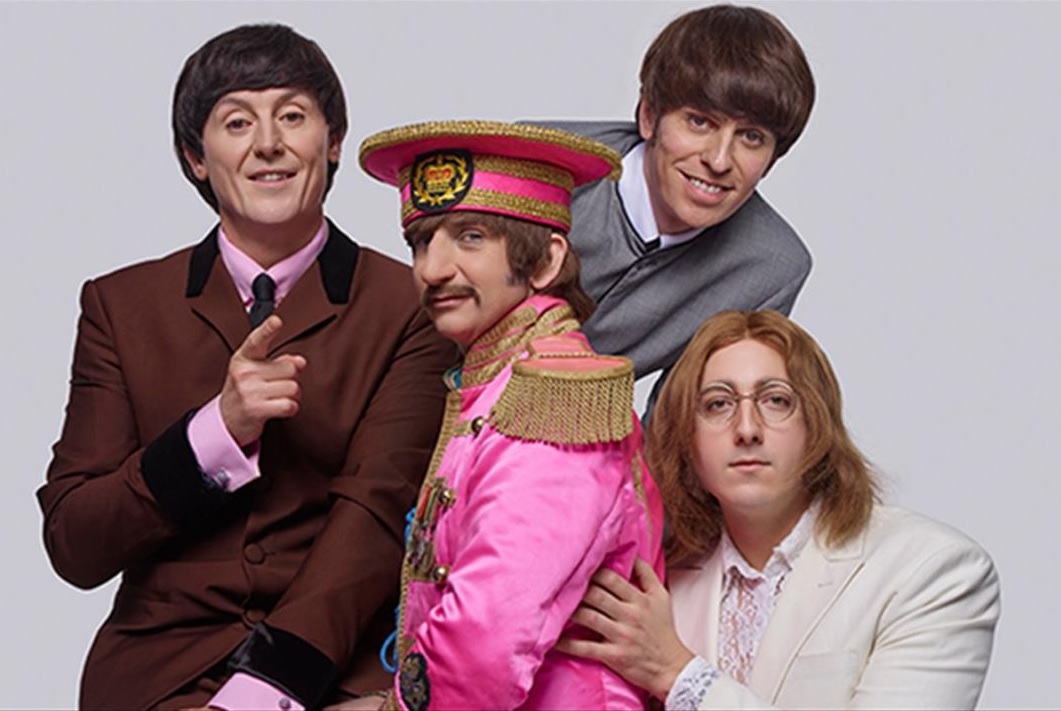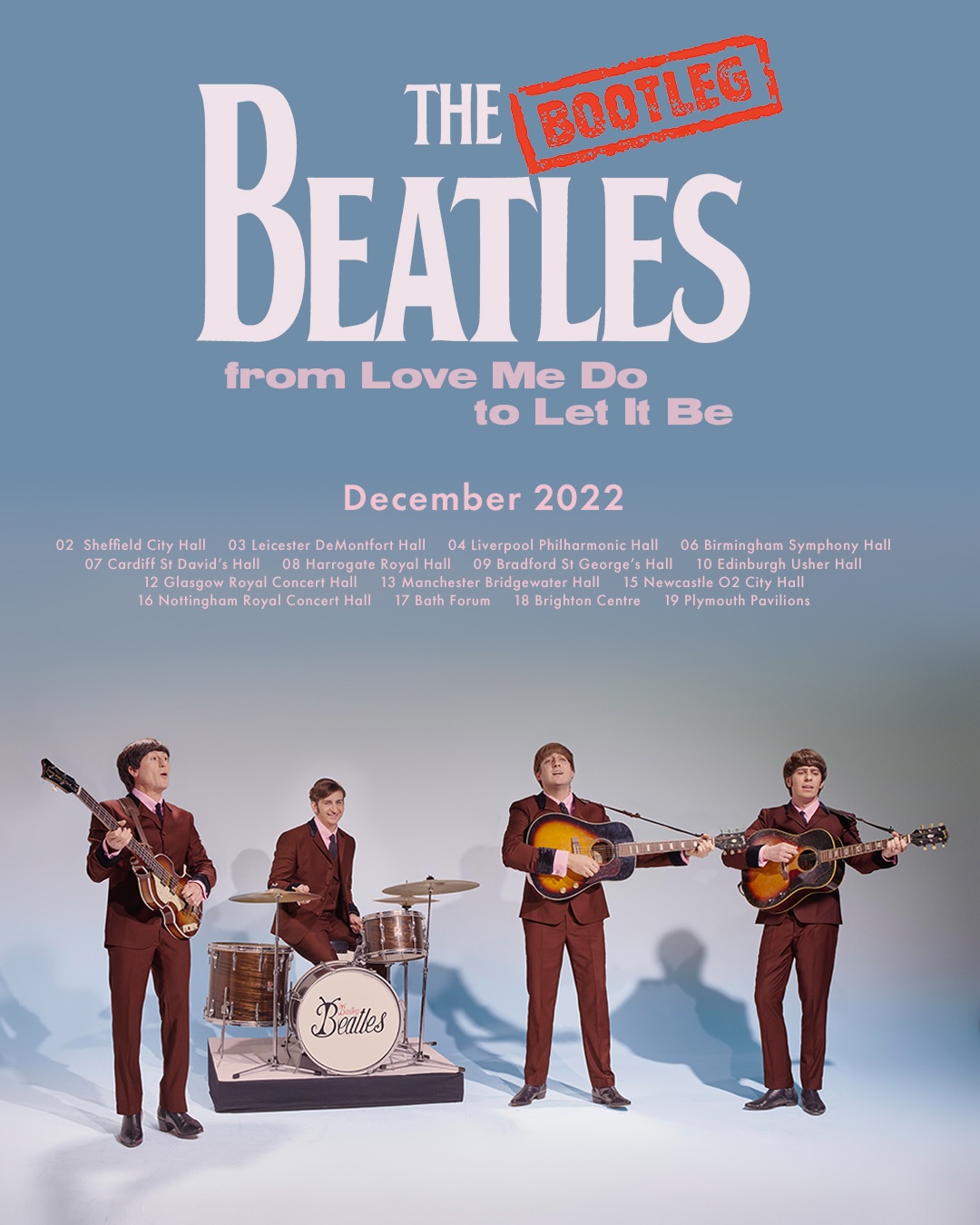
THE BOOTLEG BEATLES – BRIGHTON CENTRE 18.12.22
I’d seen The Bootleg Beatles once before, at Guilfest in 1997, when I had been mightily impressed by them. However, I’d never seen their full show before, so I was very much looking forward to tonight’s performance at the Brighton Centre. The key thing to remember about a Bootleg Beatles show is that it is a ‘show’, rather than a straightforward gig. Sure, the key element of the show is the live music that the band plays, but there is also film and recorded music, not to mention acting, as the four members of the band are very much playing parts: those of John Lennon, Paul McCartney, George Harrison and Ringo Starr.

The stage is set with a drum kit with The Beatles’ early copperplate logo on the bass drum skin, Vox AC30 amplifiers for the guitars, and a Vox bass amp. Behind the stage is a ruched red curtain of the kind that would have been common at provincial Odeon’s across the country. Pop music of the early 1960s is playing on the PA, such as ‘She Taught Me How To Yodel’ by Frank Ifield. All of the selections played illustrate how far ahead of the game The Beatles were before they had even made a record. Those early 1960s artists can’t have known what had hit them when the first three or four Beatles singles were released.

The curtain falls away to reveal a screen upon which is shown a film depicting scenes from 1962 and 1963, including the harsh 1963 winter, during which The Beatles toured in a Ford van. There is a clip from a science fiction programme (possibly ‘Dr. Who’) showing two men saying “we must be in 1963,” and the band take the stage. They rip into ‘Please Please Me’ and ‘I Saw Her Standing There’, which as a one-two opening pair of songs in 1963 would have been pretty much unbeatable. The band are dressed in brown suits with velvet collars and cuffs, which is absolutely authentic for their 1963 stage wear. This segment of the show finishes with ‘Do You Want To Know A Secret’ and ‘From Me To You’, and the band leave the stage.

It is clear from this first segment that a key element of the show is authenticity. This doesn’t just mean the way the band look, but the instrumentation used, the vocal performances, and even the stage announcements. This element of the show is very well done indeed.

While the band are offstage, footage is shown of various Merseybeat bands that followed in The Beatles’ wake, together with what would become known as ‘British Invasion’ bands, such as The Dave Clark Five. The band return to the stage and ‘John’ welcomes us to 1964. This part of the show is clearly meant to represent their first US tours, as there are frequent references to how glad they are to be in America. This time they are wearing grey suits with velvet collars, which was their 1964 US tour apparel. The bass drum skin is adorned with the more familiar Beatles logo, with the word ‘Bootleg’ added.

Many of the songs played are actually from 1963, ‘She Loves You’ and ‘All My Loving’ for example, but these were the songs that The Beatles were playing on their 1964 tours. When they play ‘I Wanna Be Your Man’, ‘John’ explains that they wrote it for a “new young band called The Rolling Stones”, who he doesn’t think will last! After ‘I Want To Hold Your Hand’ ‘Paul’ tells us that he wrote it, and introduces ‘This Boy’ as the B-side, “which John wrote”. This is pretty much the only piece of historical inaccuracy which I spotted. In 1964, Lennon and McCartney were still largely writing together, and were certainly not indulging in this kind of sniping in public. However, it does serve a purpose as a dramatic tool, as I shall explain later. Also in this section occurs the only musical error that I spot, when ‘Paul’ plays a couple of bum bass notes during ‘If I Fell’. What would Macca say?

The band leave the stage once more and we get footage from 1965-1966 including The Who and The Kinks. When the band returns they’re joined by a percussionist who later also plays keyboards. This time they’re wearing the black suits and red shirts from their Japanese tour in 1966. The instrumentation is updated too, with ‘George’ playing a Gibson SG guitar. This segment commences with ‘Paperback Writer’, which is the only song The Beatles released in 1966 that they ever played live. The harmonies work spectacularly, in marked contrast to the real thing, The Beatles finding the harmonies very difficult to replicate live. It didn’t matter when they played in front of crowds of screaming teenagers. However, when they played to Japanese audiences, who remained reverentially silent whilst the band was playing, the uncertainty of their harmonising was plainly audible. Indeed, this can be seen and heard on the second DVD of ‘The Beatles Anthology’ series. The (then) three remaining Beatles comment in the programme about how hard the harmonies were to sing.

‘Taxman’ is a real treat, the lyrics being updated to mention Boris Johnson and Liz Truss. At this point the ‘Bootlegs’ gave a plug for the super deluxe edition of The Beatles ‘Revolver’ album, “which will be coming out in 56 years’ time”. They’re joined by a brass section for ‘Got To Get You Into My Life’, and then a string section for ‘Tomorrow Never Knows’, which features ‘John’ on keyboards. This is monumentally powerful and very trippy, an excellent ending to the first set. They tell us that they’ll be back “in about twelve months” for 1967. They’re only actually away for about twenty minutes, but who’s counting?

The music played during the interval includes The Who, The Move and The Small Faces, thus putting us in the right frame of mind for what is to follow. The video shown just before the second set starts includes Jimi Hendrix, Monterey Pop Festival, hippies putting flowers into the barrels of soldiers’ guns outside the Pentagon, and more hippies frolicking in San Francisco and London.

The band return with longer hair, moustaches, and dressed in their ‘Magical Mystery Tour’ finery. The bass drum skin has the logo from the ‘Magical Mystery Tour’ film. Again the instrumentation has been updated: ‘Paul’ is on a Rickenbacker bass, whilst ‘George’ has a psychedelically painted Fender Stratocaster.

The set begins with ‘Magical Mystery Tour’, which is followed by a magisterial ‘Strawberry Fields Forever’. Here we are reminded of Paul’s announcement after ‘I Want To Hold Your Hand’, when ‘John’ tells us that he wrote ‘Strawberry Fields’, whilst Paul wrote “the B-side” ‘Penny Lane’, which they also play. Now, in no way do I want to appear to be pedantic, but ‘Strawberry Fields Forever’ and ‘Penny Lane’ was a double A-sided single, so technically there was no B-side as such.

Anyway pop-pickers, the hits just keep on coming. ‘Yellow Submarine’ was actually released in 1966, but the film of the same name came out at the end of 1968, so it’s kind of right for 1967. Also it’s backed with graphics that actually appear to be from the film. If they’re not, they’re extraordinarily similar. We get a couple more from ‘Magical Mystery Tour’ including ‘I Am The Walrus’. ‘Eleanor Rigby’ also pops up, another song that was released in 1966, and this section finishes with ‘Hello Goodbye’ and the iconic ‘All You Need Is Love’: a song that ‘John’ tells us “was written against the backdrop of the Vietnam war”. He also mentions that it makes the song sadly relevant today, which is unfortunately very true. I have a tiny issue with this section of the show: it is supposed to represent 1967, but there is not one single song from ‘Sergeant Pepper’s Lonely Hearts Club Band’, arguably THE album of 1967. This is just a minor quibble however.

Next up is 1969, which is to all intents and purposes the year that The Beatles actually split up, although it wasn’t actually announced until 1970. The accompanying film shows events such as the Paris students’ riots, and the Prague Spring, both of which occurred in 1968. Also the opening song of this section is ‘Revolution’, which was the B-side of ‘Hey Jude’, issued in 1968. This is an interesting version of ‘Revolution’, as it features the same backing vocals as ‘Revolution 1’, which was the version that appeared on the ‘White Album’. This time the band are all dressed differently to each other, and look as they did broadly around the time of the ‘White Album’ and ‘Abbey Road’. ‘George’ switches between a Gibson Les Paul and a brown Fender Telecaster (as used in the ‘Let It Be’ film), and ‘Paul’ is back on the Hofner Violin bass bearing a “Bassman” sticker, also as used in the ‘Let It Be’ film.

‘Ob-la-Di, Ob-La-Da’ mocked by ‘John’ as “a sensible song”. ‘Paul’ is back on his Rickenbacker bass for ‘Here Comes The Sun’, which is an absolute tour de force. The moog synthesiser part, which was ground-breaking for the time, is played on a flute tonight. The set (and technically The Beatles’ career) ends with ‘Let It Be’. ‘George’ plays the more raucous guitar solo from the album version, rather than the clunky solo from the single. Thus The Bootleg Beatles leave the stage, seemingly for the last time. However, unlike The Beatles, The Bootleg Beatles have time to play us an encore or two. Back they come for ‘Get Back’, and perhaps inevitably, a final encore of ‘Hey Jude’, which is how Paul McCartney usually ends his shows these days. Earlier in the show, ‘John’ had commented how he “wouldn’t like to still be doing this at like….eighty,” which is the age Paul is now. A jokey false start of ‘Mull Of Kintyre’ precedes ‘Hey Jude’, which is every bit as epic as McCartney’s present day versions.

This has been an utterly spectacular show, historically and musically accurate, and hugely enjoyable. It underlines how much of a tragedy it was that The Beatles didn’t play their later material live, and how even in the late 1960s it would have been technically possible for that material to have been performed. The main reason they didn’t play after 1966 was that they were sick of being drowned out by screaming fans. There are lots of ‘what-ifs’ where The Beatles are concerned, but what if rather than splitting, they’d gone on hiatus, and reconvened in say, 1973? We’ll never know.

The Bootleg Beatles current lineup features:
Tyson Kelly (as John Lennon) – guitar, vocals, keyboards
Steven White (as Paul McCartney) – bass, vocals
Stephen Hill (as George Harrison) – guitar, vocals
Gordon Elsmore (as Ringo Starr) – drums, vocals

The Bootleg Beatles setlist:
First set:
1963:
1. ‘Please Please Me’
2. ‘I Saw Her Standing There‘
3. ‘Love Me Do’
4. ‘A Taste Of Honey‘ (truncated)
5. ‘Anna’
6. ‘Do You Want To Know A Secret’
7. ‘From Me To You’
1964:
8. ‘She Loves You’
9. ‘All My Loving’
10. ‘I Wanna Be Your Man’
11. ‘I Want To Hold Your Hand’
12. ‘This Boy’
13. ‘A Hard Day’s Night’
14. ‘If I Fell’
15. ‘Can’t Buy Me Love’
16. ‘Twist And Shout’
1965-1966:
17. ‘Paperback Writer’
18. ‘Taxman’
19. ‘Nowhere Man’
20. ‘Got To Get You Into My Life’
21. ‘Tomorrow Never Knows’
Second Set:
1967:
22. ‘Magical Mystery Tour’
23. ‘Strawberry Fields Forever’
24. ‘Penny Lane’
25. ‘Yellow Submarine’
26. ‘Your Mother Should Know’
27. ‘I Am The Walrus’
28. ‘Eleanor Rigby’
29. ‘Hello Goodbye’
30. ‘All You Need Is Love’
1968-1969:
31. ‘Revolution’
32. ‘Ob-La-Di, Ob-La-Da’
33. ‘Here Comes The Sun’
34. ‘Let It Be’
Encore:
35. ‘Get Back’
36. ‘Mull Of Kintyre’ (false start) / ‘Hey Jude’










